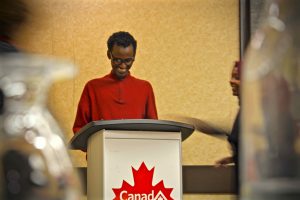by Kieran Murphy
House of Isabel, a newly opened aparment complex has already sparked controversy. The Immigrant and Refugee Community Organization of Manitoba (IRCOM) opened the apartment block a year ago. The location in the Centennial neighborhood of Winnipeg has pitteded residents and indigenous people against each other.
Dorota Blumczyńska, Executive Director of IRCOM, is painfully aware both of Canada’s colonial history and of the tensions between her organization and the local community. In the past year, IRCOM and its tenants have been victims of crimes including vandalism, theft, burglary, and assault. In August, a newcomer was attacked with pepper spray and had to be taken to the hospital.
IRCOM’s central mission is to provide transitional housing and support to low-income newcomer families with children. Families are eligible to receive IRCOM support if they have been in Canada for less than six months, and are eligible to stay for up to three years. Though IRCOM is open to all immigrants, but currently serves primarily serves refugees.
The population of the Centennial neighborhood is prodomenetaly indigenous people. It is a poor community with a robbery rate higher than the national average and median income that is a third of Winnipeg’s. Ingdoeus tenena tpreiously lived in the appartment bloock that now houses refugeesm which has stirred some resentment in the community.
Dorota Blumczyńska recognized this problem and her stratagey has been to make a conscious efforts to foster solidarity between newcomers and indigenous people, both of which she says have experiensed oppression in Canada and abroad.
Blumczyńska says every event at IRCOM starts with a territorial acknowledgement that recognizes the native claim to the land. On World Refugee Day, newcomers wrote letters to Prime Minister Trudeau about increasing funding for indigenous child welfare.
Educating newcomers about indigenous people is important in Blumczyńska’s eye’s not just because of tensions from the outside, but because many have never heard of the indigenous people of Canada, and those who have generally do not have positive impressions. IRCOM has introduced activities that recongized the mutual oppression of both communties.


